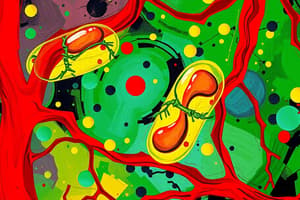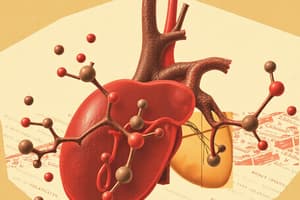Podcast
Questions and Answers
What primarily initiates atherosclerosis?
What primarily initiates atherosclerosis?
- Inflammation
- Tobacco use
- Hypertension
- Elevation of ApoB-containing lipoproteins (correct)
Atherosclerosis can occur without any endothelial damage.
Atherosclerosis can occur without any endothelial damage.
False (B)
What is formed when LDL is taken up by macrophages?
What is formed when LDL is taken up by macrophages?
Foam cells
Atherosclerotic plaques can lead to __________ or rupture causing acute ASCVD events.
Atherosclerotic plaques can lead to __________ or rupture causing acute ASCVD events.
Match the following clinical conditions with their descriptions:
Match the following clinical conditions with their descriptions:
Which lipoproteins are primarily responsible for transporting cholesterol and triglycerides throughout the body?
Which lipoproteins are primarily responsible for transporting cholesterol and triglycerides throughout the body?
Cholesterol can only be obtained through diet and cannot be biosynthesized in the body.
Cholesterol can only be obtained through diet and cannot be biosynthesized in the body.
What is the primary organ responsible for the biosynthesis of cholesterol?
What is the primary organ responsible for the biosynthesis of cholesterol?
Lipoproteins vary in characteristics depending on the amount of ______, TG, and apolipoproteins.
Lipoproteins vary in characteristics depending on the amount of ______, TG, and apolipoproteins.
Match the following lipoproteins with their primary roles:
Match the following lipoproteins with their primary roles:
Which of the following statements best describes the role of cholesterol in the body?
Which of the following statements best describes the role of cholesterol in the body?
There are three main types of lipoproteins involved in lipid transport.
There are three main types of lipoproteins involved in lipid transport.
Name one lifestyle modification that can help manage elevated dyslipidemia.
Name one lifestyle modification that can help manage elevated dyslipidemia.
What is the primary function of high-density lipoproteins (HDL)?
What is the primary function of high-density lipoproteins (HDL)?
ApoB-containing lipoproteins do not play a role in delivering cholesterol into the cells.
ApoB-containing lipoproteins do not play a role in delivering cholesterol into the cells.
What are the primary apolipoprotein-containing lipoproteins associated with atherogenic cholesterol?
What are the primary apolipoprotein-containing lipoproteins associated with atherogenic cholesterol?
LDL is the dominant form of ______ cholesterol.
LDL is the dominant form of ______ cholesterol.
Match the following lipoproteins with their primary function:
Match the following lipoproteins with their primary function:
What is the main type of lipoprotein that does not contain ApoB?
What is the main type of lipoprotein that does not contain ApoB?
Non-HDL cholesterol is calculated by adding HDL-C to total cholesterol (TC).
Non-HDL cholesterol is calculated by adding HDL-C to total cholesterol (TC).
What type of lipoprotein is primarily associated with initiating atherosclerosis?
What type of lipoprotein is primarily associated with initiating atherosclerosis?
What is a major risk factor for coronary heart disease (CHD)?
What is a major risk factor for coronary heart disease (CHD)?
Dyslipidemia is defined as a decrease in total cholesterol levels.
Dyslipidemia is defined as a decrease in total cholesterol levels.
What percentage of American adults are estimated to have total cholesterol levels of ≥ 200 mg/dL?
What percentage of American adults are estimated to have total cholesterol levels of ≥ 200 mg/dL?
In homozygous familial hypercholesterolemia, the primary defect is the inability to bind LDLC to _____ receptors.
In homozygous familial hypercholesterolemia, the primary defect is the inability to bind LDLC to _____ receptors.
Match the following terms with their definitions:
Match the following terms with their definitions:
Less than 20% of CHD patients are at their LDL cholesterol goal.
Less than 20% of CHD patients are at their LDL cholesterol goal.
In 2011, what percentage of deaths in the United States was caused by coronary heart disease?
In 2011, what percentage of deaths in the United States was caused by coronary heart disease?
What was the most prevalent risk factor for cardiovascular disease found in the 2017 study in Saudi Arabia?
What was the most prevalent risk factor for cardiovascular disease found in the 2017 study in Saudi Arabia?
Which of the following medications can increase LDL-C levels?
Which of the following medications can increase LDL-C levels?
What is the Martin-Hopkins equation used for?
What is the Martin-Hopkins equation used for?
Patients with dyslipidemia are usually symptomatic from the outset.
Patients with dyslipidemia are usually symptomatic from the outset.
A very high-fat diet is likely to increase __________ levels.
A very high-fat diet is likely to increase __________ levels.
Which of the following laboratory tests would indicate poorly controlled diabetes?
Which of the following laboratory tests would indicate poorly controlled diabetes?
Match the medical conditions with their associated lipid level impact:
Match the medical conditions with their associated lipid level impact:
The fasting lipid profile should be assessed at least every 5 years for all adults aged 20 and older who are not on lipid therapy.
The fasting lipid profile should be assessed at least every 5 years for all adults aged 20 and older who are not on lipid therapy.
What is a physical finding that may be associated with high triglycerides levels?
What is a physical finding that may be associated with high triglycerides levels?
Flashcards are hidden until you start studying
Study Notes
Cholesterol and Lipoproteins
- Cholesterol, triglycerides, and phospholipids are major lipids transported by lipoproteins.
- There are four types of lipoproteins: chylomicrons, VLDL, LDL, and HDL.
- HDL carries excess cholesterol back to the liver.
- ApoB-containing lipoproteins (non-HDL) are involved in lipid delivery and are linked to atherosclerosis.
- ApoA-1 containing lipoproteins (HDL) move cholesterol from tissues to the liver.
- Non-HDL encompasses all potentially atherogenic cholesterol and is calculated by subtracting HDL-C from TC.
Atherosclerosis
- Atherosclerosis begins with endothelial damage and dysfunction.
- Increased LDL particles permeate through the vascular wall and accumulate in the subendothelial layer.
- LDL trapped in the vascular intima is taken up by macrophages via scavenger receptors, creating foam cells.
- Smooth muscle cells migrate and encapsulate the plaque, forming a fibrous plaque.
- Atherosclerotic plaques can cause occlusion or rupture leading to ASCVD events.
- Elevated and retained ApoB-containing lipoproteins in the subendothelial layer are a primary initiator of atherosclerosis.
Atherosclerotic Cardiovascular Disease (ASCVD)
- Clinical ASCVD involves a history of ACS, MI, stable or unstable angina, coronary or arterial revascularization, stroke, TIA, or PAD.
Dyslipidemia
- Includes elevated total cholesterol, LDL cholesterol, triglycerides, or reduced HDL cholesterol.
- Dyslipidemia is the most prevalent cardiovascular risk factor.
Primary Dyslipidemias
- Caused by genetic defects resulting in hypercholesterolemia, hypertriglyceridemia, combined hyperlipidemia and disorders of HDLC metabolism.
- These disorders increase the risk of premature ASCVD due to high cholesterol levels.
- The primary defect in familial hypercholesterolemia (FH) is the inability to bind LDL to LDL receptors leading to unregulated cholesterol biosynthesis.
Secondary Dyslipidemias
- Caused by medications, dietary influences, and disease states.
- Medications such as glucocorticoids, amiodarone, diuretics, and cyclosporine can increase LDL-C.
- Oral estrogens, glucocorticoids, bile acid sequestrants, and certain other medications increase triglycerides.
Clinical Presentation and Diagnosis
- Most patients are asymptomatic for many years.
- Physical findings include abdominal pain, pancreatitis, xanthomas, and corneal arcus.
- Laboratory testing reveals elevated total cholesterol, LDL, triglycerides, apolipoprotein B, and hsCRP, with decreased HDL.
Measurement of Cholesterol
- Initial lipid profile should be done in adults 20 years and older who are not on lipid therapy.
- LDL-C can be calculated using the Friedewald or Martin-Hopkins equation.
- The Martin-Hopkins equation provides a more accurate estimation of LDL-C compared to the Friedewald equation.
Studying That Suits You
Use AI to generate personalized quizzes and flashcards to suit your learning preferences.




